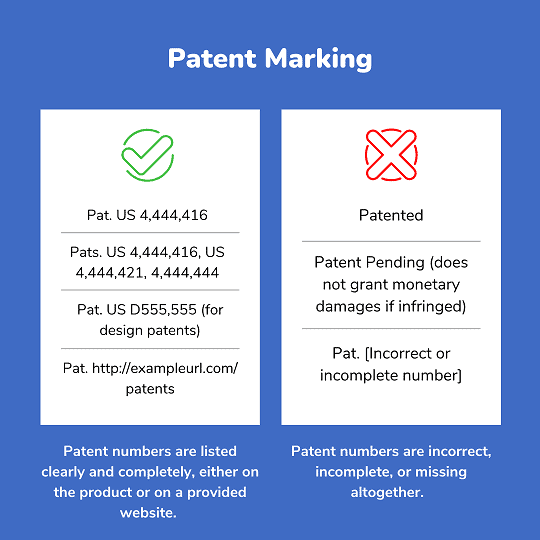You’ve worked hard to get your innovation patented. Although successfully completing the long, sometimes arduous patent process is something to celebrate, it’s just as essential to make sure other people know your invention is patented. If you don’t place a patent marking on your invention, it’s like having a billboard in a desert—nobody will know it exists, let alone if it’s validated. Moreover, marking your product serves as legal notice to anyone who might infringe on your patent.
Reasons Patent Marking Is Important
Patent marking is your proof to the public and your competitors that your product or service(s) are patented and protected. If you don’t provide proper notice, you can’t collect monetary damages from those who infringe on your patent. Patent marking is an efficient way to tell others to back off.
- Monetary gain: Marking your products significantly increases the amount of damages you may be entitled to—without a mark, someone can argue that they did not know your invention was patented. Additionally, if you find out someone’s been infringing on your patent, you can receive damages for the infringement period. Without a marking, you can only receive damages incurred after sending a cease-and-desist letter.
- Minimizes threats of unnecessary lawsuits: If you have clearly displayed proof that your IP is patented, you will prevent others from infringing on your patent for that IP—even if they didn’t know it was patented. Patent marking saves you time, money, and headaches.
- Brand enhancement: Consumers love innovation and authenticity. Monitoring your patent marking shows that you take protecting your work seriously.
https://boldip.com/wp-content/uploads/2023/06/bp-patentmarking-chart-1.png
Patent Marking Best Practices
A lot goes into protecting your patent. You’ve worked hard to get your patent approved, so you should consider these best practices when implementing and monitoring your patent marking process:
- Marked products must display the applicable patent numbers in full.
- Patented products should be marked with the relevant patents that cover the product. It is not necessary to mark method-only patents on a product.
- Make sure all your licensees and manufacturers are properly marking products with the relevant and corresponding patents. Hiring a team to specifically oversee this process may be necessary.
- Be sure to document your process. By maintaining records of how your products are marked, will be beneficial in case there is legal action later.
- If the product itself can’t be marked, mark the packaging or labeling, or use virtual marking methods. In virtual marking, you mark the work with a short URL that lists your brand’s patented products. This has the additional benefit of allowing you to change or add patents as needed.
- Patents marked on your product should cover that product in its entirety.
- You should continually review and update your patent marking to ensure they are accurate. This helps you avoid penalties due to false marking.
- Work with a patent attorney to make sure your products are patent marked correctly. A patent attorney can guide you through the marking process to be sure that your property and brand are protected.
There is no law in the United States that requires you to mark your products or services. However, not doing so will limit the damages you can recover if someone infringes on your patent(s). Thus, effective patent marking requires routine monitoring and updating to ensure the information is accurate and up-to-date.
Still have questions about patent marking your inventions? Contact the team at Bold Patents today.

